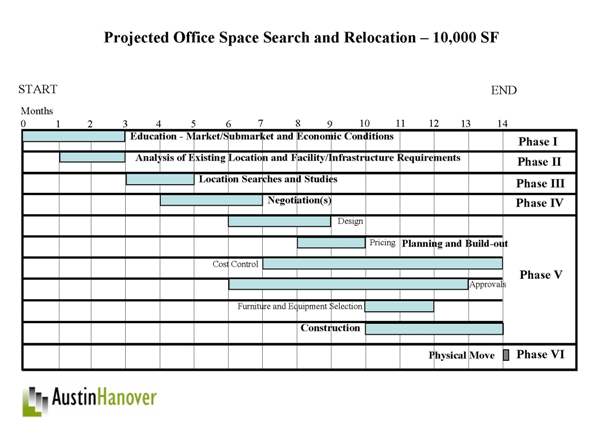| |
When Should a Business Begin
to Focus on its Next Lease?
Timetables can
vary widely depending on the sizes of space
required and specific needs. Many businesses
should begin focusing on their next leases a
minimum of two years before the expiration of
their current leases – if not significantly
farther out. While looking early does not mean
committing early, the closer a company comes to
a current lease expiration, the more a sense of
urgency will come into play and the less likely
a well negotiated and tenant-friendly lease or
lease renewal will result. And just as damaging
as poor rent terms - without the time to study,
understand and reflect on the market, current
conditions and a company’s immediate needs and
projected future needs - poorly negotiated lease
terms and/or inappropriate spaces can hound a
company for years to come.
The Benefits of Starting Early
An early start is
the best friend a lease-seeker has. While many
executives focus on the two most obvious and
dollar-defined terms, rent and tenant build-out
allowances, these two terms encompass only part
of a lease’s total costs. Focusing on pro-tenant
operating expense terms, flexibility in
subleasing, strong auditing clauses and other
tenant-right terms often has as large (or
larger) an impact on total expenses as
negotiated rent. The more time a prospective
tenant has to educate him/herself, and the more
time taken to negotiate with landlords without a
looming deadline, the more likely that tenant is
to see positive net results. And as landlords
have varying priorities, having the time to
negotiate from a position of strength and
maximizing leverages will enable a prospective
tenant to better identify a landlord’s position
and take advantage of negotiable terms and
possible trade-offs that might be of specific
import to the tenant.
As important as
defining the terms of a lease is taking the time
to identify the needs of your company – both in
the present and in the future. What are your
present constraints? Do you need more electric
capacity? Are your telecommunications needs
being met at your present location? What are
your future needs? Do you expect to expand
spatially, or perhaps outsource in the future
and flexible subleasing terms are a priority? Do
you have special datacenter needs, and if so how
do you expect them to expand across time? Taking
the time to fully and comprehensively understand
your needs is critical in choosing an
appropriate facility and in not finding yourself
settling or handcuffing yourself due to
approaching deadlines.
Landlords are in
the business of leasing space to tenants on
terms most favorable to themselves; they will
sense urgency and take advantage of it. Having
the ability to negotiate without constraint and
to freely walk away from a lengthy negotiation
that is not providing desired results, are the
keys to creating a lease that will financially
benefit your company.
Projected
Timetable
Timetables vary and will be strongly influenced
by required sizes and special needs. All
fundamentally sound office space relocations,
however, will have six components:
-
an
Educational program regarding market,
submarket and economic conditions,
-
an Analysis
of the existing location and its shortfalls
including a schematic of facility
requirements, both immediate and projected
into the future. This should be coupled with
a personnel assessment inquiry and
location-change impact projection,
-
a Location(s)
Search and Study and analysis of potential
economic incentives,
-
Negotiation(s) with one or multiple
landlord(s),
-
the Planning
and Facility Preparation Phase including
cost control and potential configurations
and build-outs,
-
the Physical
Move itself.
Below is a
projected timetable for a tenant relocation
involving a 10,000 SF facility. This projection
will expand as the desired space grows in size.
Facilities with greater footprints can require
substantially more time, particularly in
negotiation, to secure on personalized and
pro-tenant terms.

As you can see, a
relocation can be time-intensive and the more
you allow yourself for education and possible
multiple negotiations before an approaching
deadline, the more likely you are to secure a
lease and space that will financially benefit
your company for years to come. And while the
above model typifies a successful facility move
timeline for a 10,000 SF space, failed
negotiations are commonplace – allow yourself
the time to negotiate, potentially multiple
times, and do not box yourself in time-wise.
Even if your intention is to renew a lease at
your present location, you can leverage your
position and bargaining power regarding possible
build-outs and term renegotiations with local
market knowledge, and strengthen your
negotiating position by identifying potential
alternate locations. Positioning and leverage is
everything, and nowhere is that more true than
time constraints when negotiating a lease. Begin
your facility search early, create a timetable,
follow through on your efforts and position
yourself wisely.
|
|


